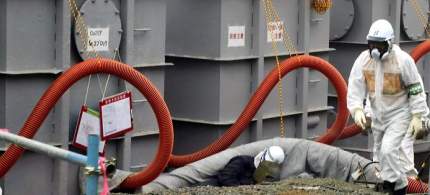 A TEPCO employee in protective clothing works around tanks filled with radioactive water at the Fukushima nuclear power plant. (photo: AAP)
A TEPCO employee in protective clothing works around tanks filled with radioactive water at the Fukushima nuclear power plant. (photo: AAP)
nytimes.com - by Hiroko Tabuchi - February 25, 2014
TOKYO — The government of Prime Minister Shinzo Abe made its biggest push yet to revive Japan’s nuclear energy program on Tuesday, announcing details of a draft plan that designates atomic power as an important long-term electricity source.
The new Basic Energy Plan, which states that Japan will push to restart reactors that were closed after the disaster in 2011 at the Fukushima Daiichi nuclear power plant, overturns a promise made by a previous government to phase out the country’s nuclear reactors. The plan also leaves open the possibility of building new plants as well as restarting existing ones.
(READ COMPLETE ARTICLE)
Problem, Solution, SitRep, or ?:
Recent Comments